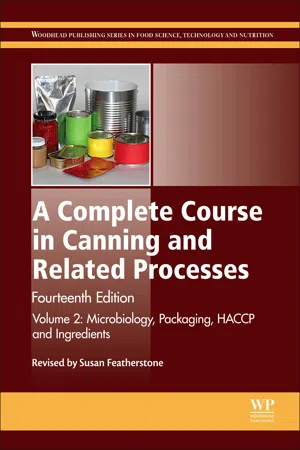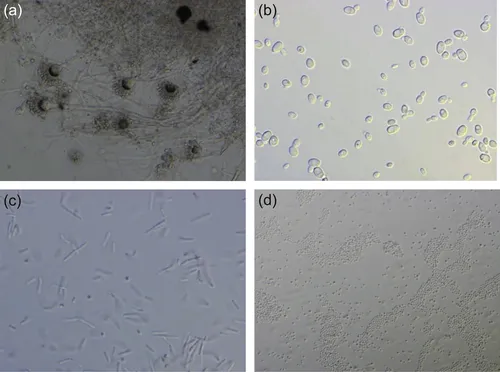
eBook - ePub
A Complete Course in Canning and Related Processes
Volume 2: Microbiology, Packaging, HACCP and Ingredients
- 376 pages
- English
- ePUB (mobile friendly)
- Available on iOS & Android
eBook - ePub
A Complete Course in Canning and Related Processes
Volume 2: Microbiology, Packaging, HACCP and Ingredients
About this book
A Complete Course in Canning is firmly established as a unique and essential guide to canning and related processes. Professionals in the canning industry and students have benefited from successive editions of the book for over 100 years. This major new edition continues that reputation, with extensively revised and expanded coverage. The three-title set is designed to cover all planning, processing, storage and quality control phases undertaken by the canning industry in a detailed, yet accessible fashion. Major changes for the new edition include new chapters on regulation and labelling that contrast the situation in different regions worldwide, updated information on containers for canned foods and new information on validation and optimization of canning processes, among many others.
Frequently asked questions
Yes, you can cancel anytime from the Subscription tab in your account settings on the Perlego website. Your subscription will stay active until the end of your current billing period. Learn how to cancel your subscription.
At the moment all of our mobile-responsive ePub books are available to download via the app. Most of our PDFs are also available to download and we're working on making the final remaining ones downloadable now. Learn more here.
Perlego offers two plans: Essential and Complete
- Essential is ideal for learners and professionals who enjoy exploring a wide range of subjects. Access the Essential Library with 800,000+ trusted titles and best-sellers across business, personal growth, and the humanities. Includes unlimited reading time and Standard Read Aloud voice.
- Complete: Perfect for advanced learners and researchers needing full, unrestricted access. Unlock 1.4M+ books across hundreds of subjects, including academic and specialized titles. The Complete Plan also includes advanced features like Premium Read Aloud and Research Assistant.
We are an online textbook subscription service, where you can get access to an entire online library for less than the price of a single book per month. With over 1 million books across 1000+ topics, we’ve got you covered! Learn more here.
Look out for the read-aloud symbol on your next book to see if you can listen to it. The read-aloud tool reads text aloud for you, highlighting the text as it is being read. You can pause it, speed it up and slow it down. Learn more here.
Yes! You can use the Perlego app on both iOS or Android devices to read anytime, anywhere — even offline. Perfect for commutes or when you’re on the go.
Please note we cannot support devices running on iOS 13 and Android 7 or earlier. Learn more about using the app.
Please note we cannot support devices running on iOS 13 and Android 7 or earlier. Learn more about using the app.
Yes, you can access A Complete Course in Canning and Related Processes by Susan Featherstone in PDF and/or ePUB format, as well as other popular books in Technology & Engineering & Food Science. We have over one million books available in our catalogue for you to explore.
Information
Part One
Microbiological hazards and process control
1
Microbiology of canned foods
Abstract
An understanding of food microbiology is important for the food processor, as it covers the micro-organisms that contaminate or create food, including the study of micro-organisms causing food spoilage and good micro-organisms that are essential for the production of foods such as cheese, yoghurt, other fermented foods, bread, beer, and wine. In this chapter bacteria important for the processor of heat-preserved foods are discussed.
Keywords
Bacteria; Botulism; Fermentation; Fungi; Micro-organism; Mould; Spoilage1.1. Introduction
Microbiology is the study of any living thing that is too small to be seen with the naked eye. These tiny creatures are referred to as microbes or micro-organisms. Examples of micro-organisms are viruses, fungi, and bacteria. Micro-organisms were first discovered just over 300 years ago, and although this science is continually advancing, probably only a very small percentage of all of the micro-organisms on earth are known, and even fewer are understood. Micro-organisms are essential to life. They live symbiotically with plants and animals, and help to purify water, degrade waste and dead plants and animals, and put nutrients back into the soil. Certain types of micro-organisms colonise our intestines and help us to digest our food, without which we could not survive. However, the presence of micro-organisms can also be detrimental, as they can cause structural damage to buildings, degrade valuable books, clothes and artefacts, and destroy our food by breaking it down to make it unpalatable and in some instances, toxic. The potential for micro-organisms to render food inedible is the reason why all methods of food preservation, of which canning is one, have developed.
1.1.1. Food microbiology
As soon as food is harvested or slaughtered it starts deteriorating, by both biochemical processes and as a result of microbiological action. It is the challenge of food scientists to keep food in the best quality and safe to eat, while being able to be able to harvest, transport, and store it to supply urban populations with fresh, nutritious food throughout the year. Food microbiology is a study of the micro-organisms that cause loss of food quality and safety, as well as those organisms that help to preserve the food and keep other organisms at bay. The micro-organisms of importance in the food industry are yeasts and moulds (fungi), bacteria, and to a lesser extent viruses. Figure 1.1 shows the size of an animal cell relative to mould, yeast, and bacteria. It is critical that the food processor knows and understands about the various micro-organisms that can cause food spoilage and food poisoning for the products he or she is manufacturing.
The term ‘micro-organism’ describes a group of living cells that are incredibly diverse. They are found all over the earth: on our bodies and in our food to the most extremely hostiles areas, deep under the oceans, in the freezing snow, and in hot springs from geysers. The can breathe air as we do (aerobic) or live without any oxygen (anaerobic), as well as various adaptations in between. The different types of micro-organisms relevant to food microbiology, food spoilage, and canning are discussed in the next sections.

Figure 1.1 Diagram showing the relative size of micro-organisms.
1.2. Key micro-organisms in food microbiology
1.2.1. Fungi
Fungi are neither plant nor animal. Like plants, they possess a cell wall and can reproduce sexually and have a sophisticated life-cycle; but like animals, they do not contain chlorophyll and are heterotrophic organisms (they get nourishment by digesting plant or animal matter). The majority of fungal species (moulds) grow as multicellular filaments, called hyphae, forming a mycelium. Some fungal species (yeasts) also grow as single cells. Reproduction of the fungi is commonly via spores, often produced on specialised structures or in fruiting bodies. The study of fungi is known as mycology. Fungi are used extensively in food preservation. Yeasts ferment barley into beer, grapes into wine, and cause bread to rise. Moulds are used in the production of cheese and soy sauce. Certain fungi are used for antibiotic production. Many fungi produce mycotoxins (biologically active compounds), some of which can be toxic to humans and animals. The name ‘mycotoxin’ comes from the Greek words, ‘mykes’ (mould) and ‘toxicum’ (poison).
1.2.1.1. Moulds
Moulds include all species of microscopic fungi that grow in the form of multicellular filaments, called hyphae. The individual mould structures, single hypha or spores, can only be seen under a microscope (see Figure 1.2(a)). The term ‘mould’ describes the mass of mycelium, made up from many hyphae, that is visible as a colony with the naked eye. Moulds are found in the soil and in the air. Under suitable conditions of moisture, temperature, and oxygen, they can grow on almost any food source. They can grow at many different extremes: highly acidic, very salty, low temperature, and on carbon sources that are not generally considered to be food (for example, ceilings, walls, books). All moulds are aerobic (need to live in an environment that contains oxygen), but some can grow in relatively low oxygen concentrations. Generally, moulds are not very heat resistant, but some spores can survive heating to about 90 °C for a few minutes. Mature spores (ones that have had several days to mature) are generally more resistant. These present problems for fruit canning, where the process severity is limited due to the breakdown in fruit texture caused by heat. One important feature of mould metabolism that is important to note is the ability to consume acids, thus raising the pH of a foodstuff, and potentially allowing other micro-organisms to grow that were otherwise inhibited by the low pH.

Figure 1.2 Photographs of mould, yeast and bacteria. (a) Mould (200× magnification). (b) Yeast (200× magnification). (c) Rod-shaped bacteria, with spores (1000× magnification). (d) Cocci (round-shaped) bacteria (1000× magnification).
1.2.1.2. Yeasts
Yeasts may be generally viewed as unicellular fungi and are much larger than bacteria (see Figures 1.1 and 1.2(b)). They are found everywhere: in the soil, in orchards and vineyards, in the air, as well as in the intestinal tract of animals. Yeasts are heterotrophs that use organic compounds as a source of energy and do not require sunlight to grow. The main source of carbon is from sugars such as glucose and fructose, or disaccharides such as sucrose and maltose, although some species can metabolise pentose sugars (e.g. ribose), alcohols, and organic acids. Yeasts are either obligate aerobes or are facultative anaerobes. Unlike bacteria, yeast species cannot grow strictly anaerobicall...
Table of contents
- Cover image
- Title page
- Table of Contents
- Related titles
- Copyright
- Woodhead Publishing Series in Food Science, Technology and Nutrition
- Preface
- Introduction
- Part One. Microbiological hazards and process control
- Part Two. Containers and ingredients
- Part Three. Safety and quality
- Appendix
- Glossary
- Index